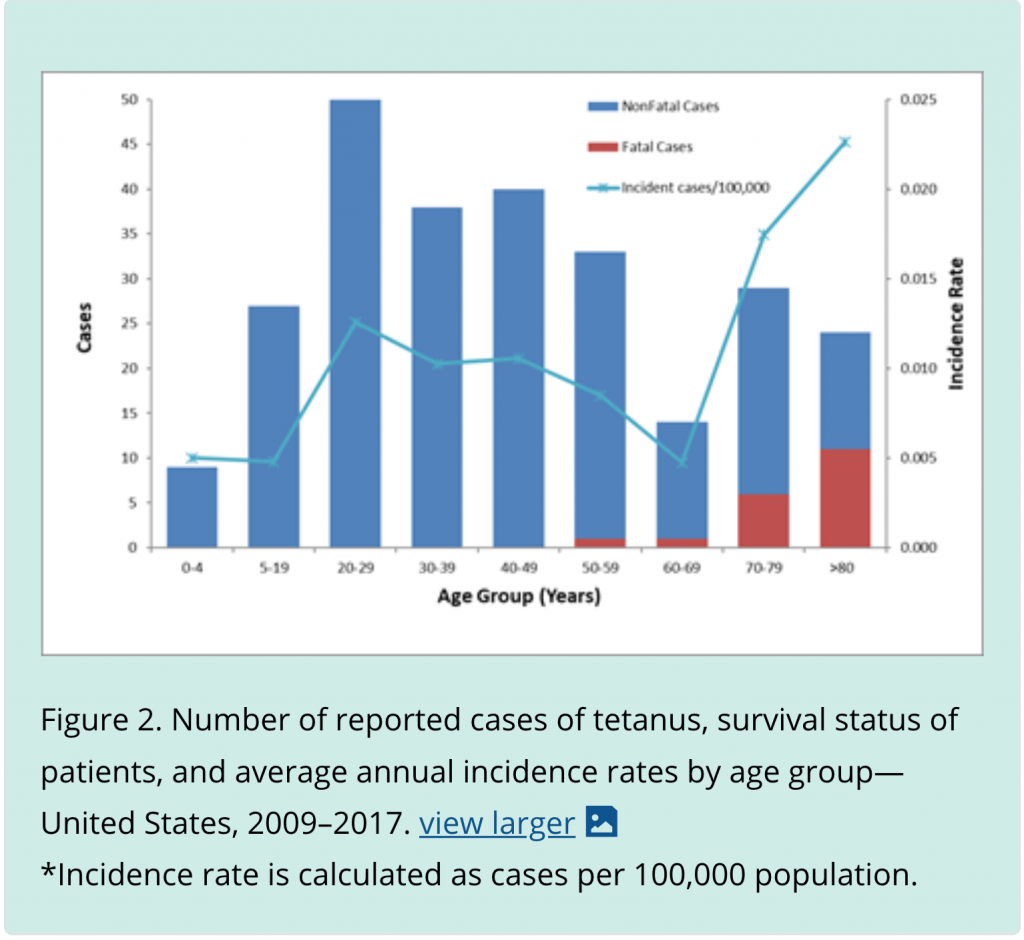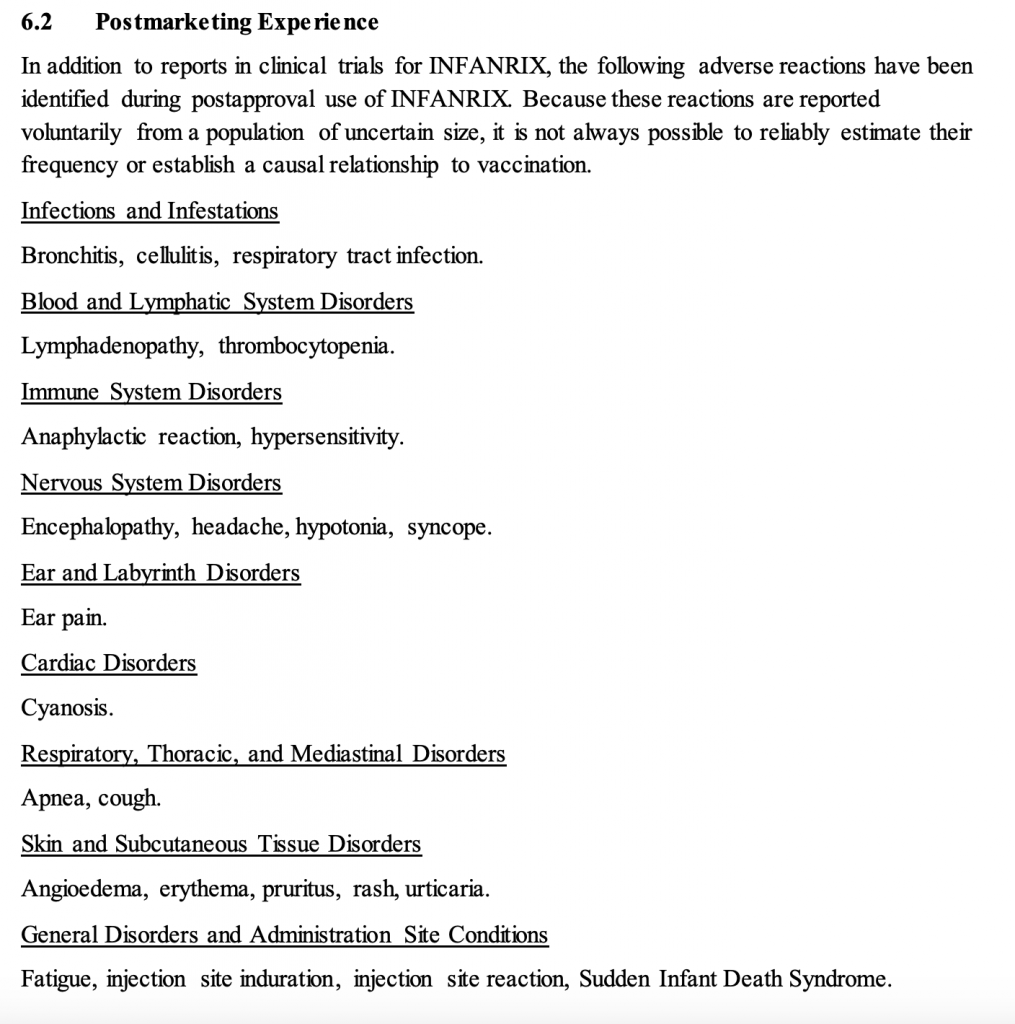Ok so now we can go over the second part of DTaP: Tetanus. As a recap, DTaP is recommended according to the CDC’s schedule at: 2mo, 4mo, 6mo, 15mo & 5 years, 11years, then every 10 years after that, and every pregnancy (regardless of when you had it last.). So how many cases of tetanus are there each year in the US and how many deaths from it?
What is tetanus? Straight from the CDC, “Tetanus is an infection caused by a bacterium called Clostridium tetani. Spores of tetanus bacteria are everywhere in the environment, including soil, dust, and manure. The spores develop into bacteria when they enter the body.
The spores can get into the body through broken skin, usually through injuries from contaminated objects. Tetanus bacteria are more likely to infect certain breaks in the skin. These include:
- Wounds contaminated with dirt, poop (feces), or spit (saliva)
- Wounds caused by an object puncturing the skin (puncture wounds), like a nail or needle
- Burns
- Crush injuries
- Injuries with dead tissue”. (cdc.gov/tetanus)
“People often call tetanus “lockjaw” because one of the most common signs of this infection is tightening of the jaw muscles. Tetanus infection can lead to serious health problems, including being unable to open the mouth and having trouble swallowing and breathing.” (cdc.gov/tetanus)
Doesn’t sound that fun at at all. So how many cases are there each year?
Let’s look what the CDC says, “Today, tetanus is uncommon in the United States, with an average of about 30 reported cases each year.” (cdc.gov/tetanus). WHAT? Did you read that correctly? Yes be assured you did, there are only on average 30 reported cases of tetanus each year in the US. Do you know how many people are in the US? 331,002,651 people (worldometers.into) So let’s do the math for your chances of getting it. 331,002,651 people divided by the cases per year average 30 = 11,033,422. So your chances of getting it would be 1 in 11 MILLION. Changes of dying from it? Even slimmer, let’s take a look.
From the CDC, “In 2017, a total of 33 tetanus cases and 2 deaths were reported through the National Notifiable Diseases Surveillance System (NNDSS).[2]. From 2009 through 2017, a total of 264 cases and 19 deaths from tetanus were reported in the United States. Sixty (23%) cases were in persons 65 years of age or older, 168 (64%) were in persons 20 through 64 years of age, and 36 (13%) were in persons younger than 20 years, including 3 cases of neonatal tetanus (cdc.gov/vaccines)

From 2009 through 2017 there have been 19 deaths from tetanus in the US. All tetanus-related deaths occurred among patients >55 years of age.[2]”. (cdc.gov/vaccines). From this cdc graph it looks like 2 of the 19 deaths were ages 55 to 69, the other 17 deaths were ages 70 and older. So it is looking like a child has about a 1 in 11 MILLION chance of getting tetanus and 0% chance of death from tetanus.

On a side note what can be done if you do get tetanus? (Even if you got the vaccine you can still get tetanus.) If you get tetanus, you will receive tetanus immune globulin (TIg). “Tetanus immune globulin (TIg) provides immediate, short-term protection against the bacteria that cause tetanus (lockjaw). TIg contains large amounts of antibodies taken from donated human blood.” (Healthlinkbc.ca)
So does it make sense to give our children 5 doses of DTaP by 5years old? Especially if they have a short term protection if you do get tetanus? Just a few things to think about….
Let’s look at the DTaP insert to see what it has to say:
“Encephalopathy (e.g., coma, decreased level of consciousness, prolonged seizures) within 7 days of administration of a previous dose of a pertussis-containing vaccine that is not attributable to another identifiable cause is a contraindication to administration of any pertussis-containing vaccine, including INFANRIX.” (Infantrixinsert)
“If Guillain-Barré syndrome occurs within 6 weeks of receipt of a prior vaccine containing tetanus toxoid, the decision to give any tetanus toxoid-containing vaccine, including INFANRIX, should be based on careful consideration of the potential benefits and possible risks.” (Infantrixinsert)
“Syncope (fainting) can occur in association with administration of injectable vaccines, including INFANRIX. Syncope can be accompanied by transient neurological signs such as visual disturbance, paresthesia, and tonic-clonic limb movements. Procedures should be in place to avoid falling injury and to restore cerebral perfusion following syncope.”(Infantrixinsert)

Has Sudden Infant Death happed following this vaccine? YES look at the last line of this picture!!!

I hope this gives you more incite into the risk benefit analysis of this vaccine.